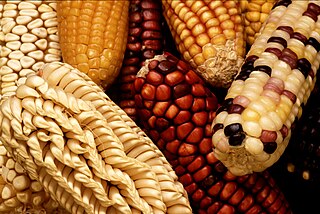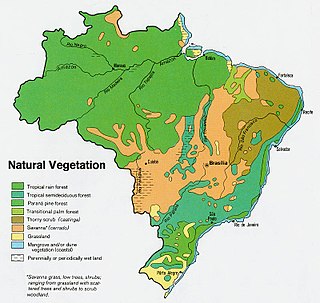
The Convention on Biological Diversity (CBD), known informally as the Biodiversity Convention, is a multilateral treaty. The Convention has three main goals: the conservation of biological diversity ; the sustainable use of its components; and the fair and equitable sharing of benefits arising from genetic resources. Its objective is to develop national strategies for the conservation and sustainable use of biological diversity, and it is often seen as the key document regarding sustainable development.

Protected areas or conservation areas are locations which receive protection because of their recognized natural, ecological or cultural values. Protected areas are those areas in which human presence or the exploitation of natural resources is limited.
This is an index of conservation topics. It is an alphabetical index of articles relating to conservation biology and conservation of the natural environment.

Ex situ conservation is the process of protecting an endangered species, variety or breed, of plant or animal outside its natural habitat. For example, by removing part of the population from a threatened habitat and placing it in a new location, an artificial environment which is similar to the natural habitat of the respective animal and within the care of humans, such as a zoological park or wildlife sanctuary. The degree to which humans control or modify the natural dynamics of the managed population varies widely, and this may include alteration of living environments, reproductive patterns, access to resources, and protection from predation and mortality.
Rio Convention relates to the following three conventions, which were agreed at the Earth Summit held in Rio de Janeiro in June 1992.

Agricultural biodiversity or agrobiodiversity is a subset of general biodiversity pertaining to agriculture. It can be defined as "the variety and variability of animals, plants and micro-organisms at the genetic, species and ecosystem levels that sustain the ecosystem structures, functions and processes in and around production systems, and that provide food and non-food agricultural products.” It is managed by farmers, pastoralists, fishers and forest dwellers, agrobiodiversity provides stability, adaptability and resilience and constitutes a key element of the livelihood strategies of rural communities throughout the world. Agrobiodiversity is central to sustainable food systems and sustainable diets. The use of agricultural biodiversity can contribute to food security, nutrition security, and livelihood security, and it is critical for climate adaptation and climate mitigation.
The 2010 Biodiversity Target was an overall conservation target aiming to halt the decline of biodiversity by the end of 2010. The world largely failed to meet the target.

A biodiversity action plan (BAP) is an internationally recognized program addressing threatened species and habitats and is designed to protect and restore biological systems. The original impetus for these plans derives from the 1992 Convention on Biological Diversity (CBD). As of 2009, 191 countries have ratified the CBD, but only a fraction of these have developed substantive BAP documents.
The Canadian Biodiversity Strategy has been prepared in response to Canada's obligations as a party to the United Nations Convention on Biological Diversity. The Strategy has been developed as a guide to the implementation of the Biodiversity Convention in Canada.

The Biodiversity Indicators Partnership (BIP) brings together a host of international organizations working on indicator development, to provide the best available information on biodiversity trends to the global community. The Partnership was initially established to help monitor progress towards the Convention on Biological Diversity (CBD) 2010 Biodiversity target. However, since its establishment in 2006 the BIP has developed a strong identity not only within the CBD but with other Multilateral Environmental Agreements (MEAs), national and regional governments and other sectors. As a result, the Partnership will continue through international collaboration and cooperation to provide biodiversity indicator information and trends into the future.
The Plant List was a list of botanical names of species of plants created by the Royal Botanic Gardens, Kew and the Missouri Botanical Garden and launched in 2010. It was intended to be a comprehensive record of all known names of plant species over time, and was produced in response to Target 1 of the 2002–2010 Global Strategy for Plant Conservation, to produce "An online flora of all known plants". It has not been updated since 2013, and has been superseded by World Flora Online.
Indigenous and community conserved areas (ICCAs), or Indigenous peoples’ and community conserved territories and areas, are spaces de facto governed by Indigenous peoples or local communities with evidently positive outcomes for the conservation of biological and cultural diversity. In ICCAs, the continuation, revival, or modification of traditional practices and/or new initiatives succeed in protecting and restoring natural resources and cultural values in the face of new threats or opportunities. Some ICCAs are situated in remote ecosystems that have had minimum human influence, while others encompass areas of various regulations and magnitudes within regions strongly affected or modified by human occupation. ICCAs may or may not fit the IUCN definition of “protected area” but, when they do, they can fall into any IUCN protected area categories.

The World Checklist of Selected Plant Families was an "international collaborative programme that provides the latest peer reviewed and published opinions on the accepted scientific names and synonyms of selected plant families." Maintained by the Royal Botanic Gardens, Kew, it was available online, allowing searches for the names of families, genera and species, as well as the ability to create checklists.
The FairWild Foundation is an international organization that aims to provide a global framework for a sustainable and fair trading system for wild-collected plant ingredients and their products. It was established in 2008 in response to the major ecological and social challenges created by the ever-increasing demand for wild plant ingredients used in food, cosmetics, well-being and medicinal products.

Lista de espécies da flora do Brasil, first produced in 2010 provides a list of species of plants found in Brazil. At that time it listed a total of 40,982 species, including 3,608 fungi, 3,495 algae, 1,521 bryophytes, 1,176 pteridophytes, 26 gymnosperms and 31,156 angiosperm species. The list is constantly updated with more than 400 taxonomists working on the online database.

Plant genetic resources describe the variability within plants that comes from human and natural selection over millennia. Their intrinsic value mainly concerns agricultural crops.

World Flora Online is an Internet-based compendium of the world's plant species.
Tropical Important Plant Areas (TIPAs) is a programme established by the Royal Botanic Gardens, Kew in 2015 in collaboration with Plantlife International, to provide a framework to identify sites important for preserving plant diversity in tropical countries. The programme is based on the Important Plant Areas (IPAs) framework set up by Plantlife International. The IPA criteria were modified to take into account the high plant richness, the limited availability of data and the higher dependence on socio-economically important yet native plants for livelihoods in the tropics. The framework acknowledges the practical problems of gathering plant and habitat data in many regions of the world, and it recognises the important role of peer reviewed expert opinion in the selection process. TIPAs can be identified based on a range of organism groups within the plant and fungal kingdoms, including algae, fungi, lichens, liverworts, mosses, and wild vascular plants. The TIPAs programme focuses on critical sites for wild plant populations. It aims to identify areas important for the conservation of threatened plants and/or habitats and areas with exceptional plant richness, and to raise awareness of the importance of plant life in tropical countries, encouraging long term conservation of these areas. TIPA sites are selected based on three criteria:
Index Seminum meaning in Latin "seed index", is a catalog of seeds of wild or cultivated plants offered free of charge or in exchange of seeds of equivalent value by botanical gardens or arboretums. It is published annually or biennially by these institutions, traditionally in A5 format. Seeds presented in Index Seminum are readily available and kept in seed banks. More than 1000 institutions from 48 countries publish Index Seminum with the intention of establishing a free and fair exchange. The exchange of seeds and spores constitutes one of the main ways of increasing the living collections of botanical gardens, and is also a way of obtaining material for the development of research work.

Sustainable Development Goal 15 is about "Life on land". One of the 17 Sustainable Development Goals established by the United Nations in 2015, the official wording is: "Protect, restore and promote sustainable use of terrestrial ecosystems, sustainably manage forests, combat desertification, and halt and reverse land degradation and halt biodiversity loss". The Goal has 12 targets to be achieved by 2030. Progress towards targets will be measured by 14 indicators.










